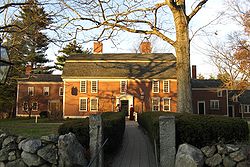 Sudbury MA was incorporated in 1639. At that time, the boundaries Sudbury included (by 1653) all what is now of Wayland (which split off in 1780), and parts of Framingham, Marlborough, Stow and Maynard.The Sudbury Center Historic District has changed little since 1800.
Sudbury MA was incorporated in 1639. At that time, the boundaries Sudbury included (by 1653) all what is now of Wayland (which split off in 1780), and parts of Framingham, Marlborough, Stow and Maynard.The Sudbury Center Historic District has changed little since 1800.
Sudbury also contributed the most militia during King Philip’s War and was the site of a native raid. One main contributor was Ephraim Curtis who put up only victories for the militia of West Sudbury.Sudbury militia participated in the Battle of Lexington and Concord, in 1775, where Sudbury members sniped on British Red Coats returning to Boston. One of Sudbury’s historic landmarks, the Wayside Inn, claims to be the country’s oldest operating inn, built and run by the Howe family for many generations. Henry Wadsworth Longfellow wrote Tales of a Wayside Inn, a book of poems published in 1863. In the book, the poem The Landlord’s Tale was the source of the immortal phrase “listen my children and you shall hear, of the midnight ride of Paul Revere.” The property was owned, restored and expanded by Henry Ford between 1923 and 1940. The expansion included a boys school, the Old Grist Mill, the Martha-Mary Chapel and the Redstone Schoolhouse, reputed to be the school in Sarah Josepha Hale’s nursery rhyme Mary Had a Little Lamb, which was moved from Sterling.However, Giuseppi Cavicchio’s refusal to sell his water rights scuttled Henry Ford’s plans to build an auto parts factory at the site of Charles O. Parmenter’s mill in South Sudbury.
In August 1925, a Sudbury farm was the scene of a riot between local members of the Ku Klux Klan and Irish-American youths from the area. Five people were wounded by gunshots, and the State Police arrested over 100 Klansmen. Massachusetts officials cracked down on the group’s meetings theafter, and the area Klan died out. In the post-war period, Sudbury experienced rapid growth in population and industry. Defense contractor Raytheon became a major employer after opening a large research facility in Sudbury in 1958. Another major employer in that period was Sperry Rand. In the 1970s, the town was home to many of the engineers working in the minicomputer revolution at Digital Equipment Corporation in nearby Maynard. Sudbury was also one of the largest carnation-growing towns, with many greenhouse operations.



